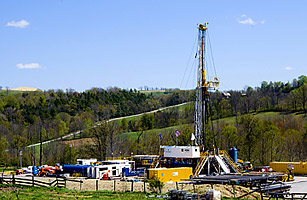
When I traveled through northeastern Pennsylvania in March for my TIME cover story on shale natural gas, it wasn’t hard to find unhappy homeowners like Sherry Vargason. Vargason, who lives on a cattle farm in rural Bradford County, has leased her land for shale-gas exploration, and a well was drilled a few hundred feet from her front door. Not long after, she began to experience problems with her water, which comes from an underground well on her property. It turned out she had unusually high levels of methane in her water — so high, in fact, that it posed an explosive threat to her home.
Methane is the main component of natural gas, and Vargason naturally connected the methane in her water to the gas operation just outside her home. But though the gas company installed a venting system on her well to reduce methane buildup, they denied there was any connection between drilling and contamination — a position the industry as a whole has maintained for years. “Unless you can prove how the contamination came, you can’t do anything about it,” Vargason told me.
As it turns out, however, that proof may not be so elusive. A new study published in the May 9 Proceedings of the National Academy of Sciences shows that methane levels in water wells near shale-gas hydrofracking sites is 17 times higher than they are in wells that are far from shale-gas operations. The peer-reviewed paper is the first independent scientific confirmation of something advocates, environmentalists and homeowners have passionately argued, and that the gas industry has vociferously denied. “We found a clear relationship between how near someone’s drinking water was to a gas well and the concentration of methane in the water,” says Robert Jackson, the director of Duke University’s Center on Global Change and a co-author of the PNAS study.
The Duke researchers collected and analyzed water samples from 68 private groundwater wells across five counties in northeastern Pennsylvania and New York state where hydrofracking is taking place. Sixty of those wells were tested for dissolved methane, and most of those showed some levels of the gas. That’s not terribly unusual — low levels of methane are often present in groundwater in that region, a fact that gas companies constantly cite when defending themselves from accusations of environmental contamination. But the study found that the water samples taken closest to gas wells had concentrations of methane that reached the dangerous level, enough to require urgent “hazard mitigation” action. And the researchers can say with confidence that the methane in the affected water wells came from drilling; they analyzed the dissolved gas — generating a sort of chemical fingerprint — and found that it was thermogenic methane, which comes from the same rock layers targeted by gas drillers.